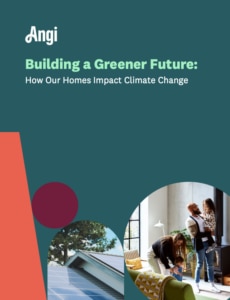
This Earth Day we are excited to partner with Team Zero, a non-profit charitable and educational organization on a mission toward a zero energy, zero carbon future for our homes. At Angi we believe the home is the most important place on earth and know we have a role to play in making our homes more sustainable. We are excited to be working with Team Zero to educate and inform homeowners and home pros across the U.S. about a greener future.
Key Facts:
- Housing produced 16% of the United States’ total greenhouse gas emissions in 2020, according to the EPA.
- More homeowners are making simple changes to reduce their greenhouse gas contributions – and to cut costs.
- Retrofitting homes is the swiftest path to reducing the housing stock’s greenhouse gas emissions.
- Energy audits help homeowners understand where they can make the most impactful changes
Angi Report

Check out the new report from Angi – Building a Greener Future: How our Homes Impact Climate Change
“At our current booming home construction rate, it would still take 109 years to completely rebuild and replace the entire national housing stock of 141 million housing units. That means both current and future homeowners will be the ones responsible for helping make existing homes greener.”
Tips for a Greener Home
Here are four smart, relatively affordable solutions homeowners can implement quickly.
Install Better Insulation, Air Sealing, and Ventilation to Cut Costs
- Caulking, insulation, and Energy Star-certified windows may be homeowners’ best friends for reducing energy costs and keeping homes more comfortable year-round. The Department of Energy states that 45% of homeowners’ energy use goes to heating and 9% to cooling. Keeping air in (and out) means energy-efficient comfort and cost-cutting.
Upgrade Heating and Cooling for Easy Energy Savings
- Heat pumps don’t get a lot of love—but they should. Heat pumps pull warm, outdoor air indoors during the cooler months and, during the warmer months, pull indoor air out of homes to keep indoor temperatures comfortable.
- Heat pumps could offer 300% to 400% efficiency improvements over top-tier gas appliances with even 90% efficiency ratings. Heat pumps don’t need gas or fuel to function, and heat pumps cost less than $6,000 on average, making them an excellent investment both financially and environmentally. Your local heat pump installer can have it set up in no time.
Install Solar Panels and Battery Storage to Offset Utility Expenses
- There may be no better symbol of “green” than solar panels. As of 2020, there were nearly 3 million residential photovoltaic solar systems. While most solar panels cost between $17,000 and $32,000, you can save around $600 a year on energy costs, allowing you to return your investment over time
- But if you still have sticker shock, there are several local and federal solar panel incentives to help homeowners switch to solar.
Not everyone can afford solar panels or a top-of-the-line heat pump at the moment—or any time soon. However, homeowners can still reduce their footprints by making small, cost-effective changes today by simply:
- Switching to low-power LED lights
- Opting for recyclable and recyclable materials
- Swapping old, energy-hungry appliances for Energy Star-rated appliances
- Updating toilets and showerheads to low-flow models
- Xeriscaping or including low-water landscaping
- Upgrading to smart home devices like smart thermostats and smart lighting

 Press & Media Inquiries
Press & Media Inquiries Angi Economics
Angi Economics